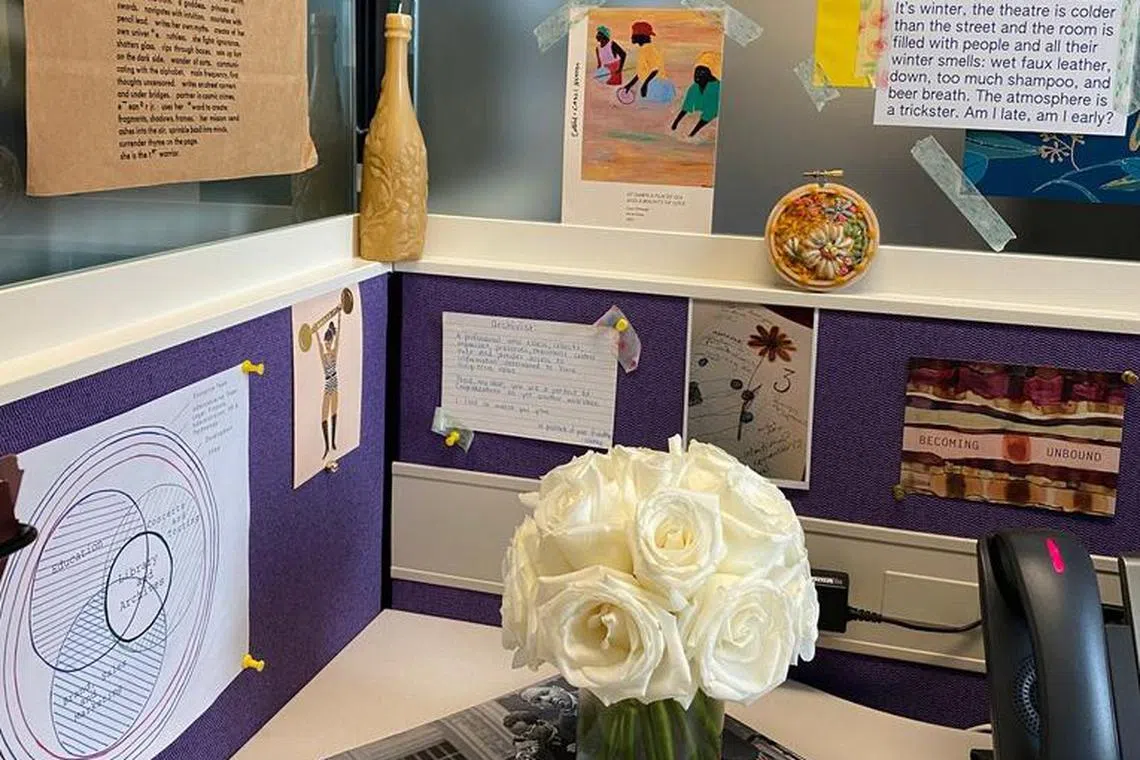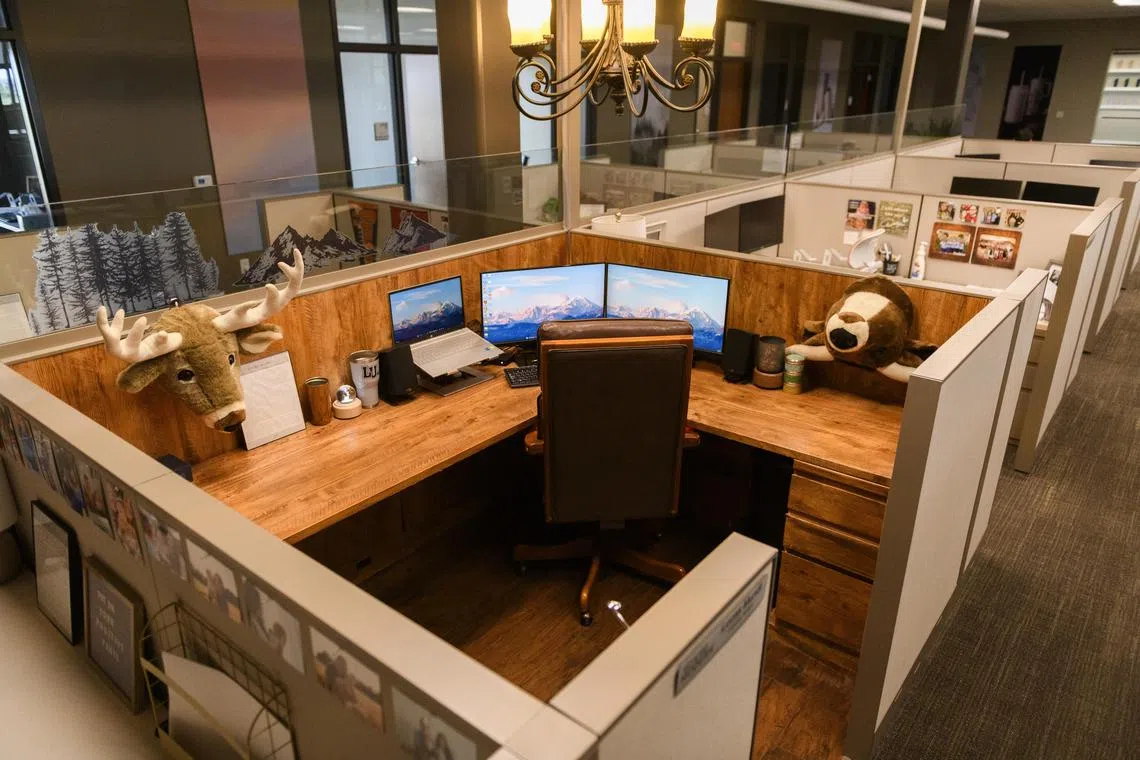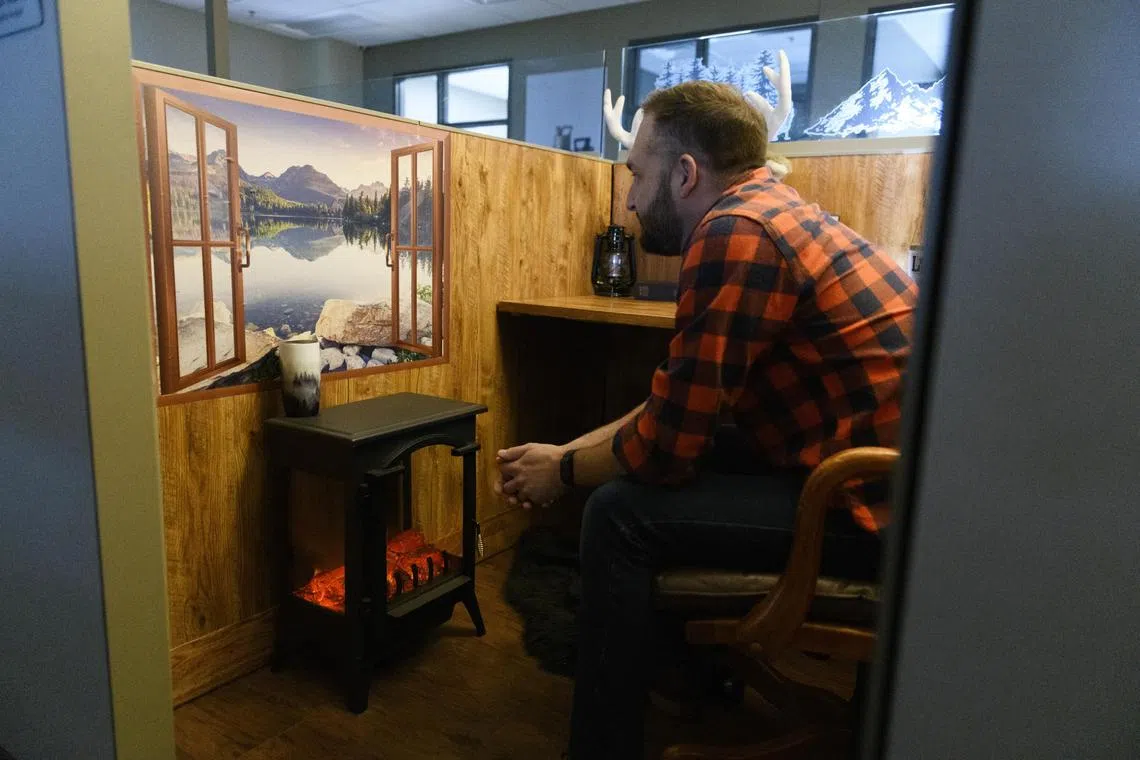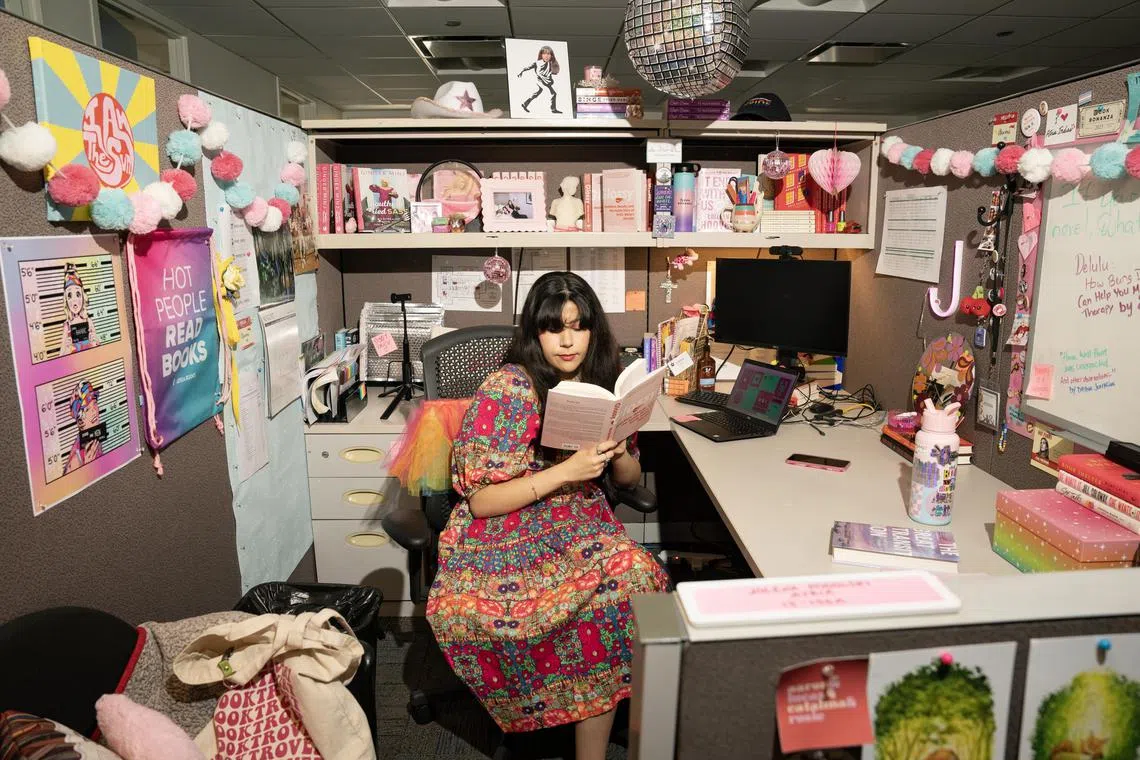As office workers make their return, so does the lowly cubicle
Sign up now: Get ST's newsletters delivered to your inbox

Once derided as symbols of a commodified workforce, cubicles are making a comeback, and workers are personalising them and posting photos on social media.
PHOTO: NYTIMES
Follow topic:
Among office designers and architects, cubicles are rarely mentioned. The once-ubiquitous fixture, so popular in the 1980s and ’90s, has become vilified as a sign of the dehumanisation of the workforce. Design experts today say cubicles are a “hard no”.
And yet cubicles, like scrunchies, are back, spurred by demand from employers and employees alike.
“I frankly thought the cube market was dying,” said Mr Brian Silverberg, who sells refurbished and used office furniture with his brother, Mark, at their store, the Furniture X-Change in North Brunswick, New Jersey. “We have sold more cubes in the last three years than in the five years before,” he said, adding that 2024 would be “bigger than this year”.
Covid-19 was an amplifier of a trend that preceded the pandemic. But as employees returned to the office after months of working at home, quiet spaces became more important, said Ms Janet Pogue McLaurin of Gensler. “We had seen a drop in effectiveness because of noise interruptions, disruptions and a general lack of privacy.”
Global demand has pushed cubicles and partitions to a US$6.3 billion (S$8.37 billion) market, which is expected to grow over the next five years to US$8.3 billion, according to a 2022 report from Business Research Insights, a market analysis firm.
Furniture manufacturers had already recognised that workers wanted some privacy despite the tendency of employers to value collaborative areas more highly than individual workspaces.
Anyone who has ever worked in an office with benches “hates the open plan”, said Mr Michael Held, vice-president of global design at the furniture-maker Steelcase.
Working from home during the pandemic offered some relief from noisy co-workers, but it also brought new distractions, including constant interruptions by family members and roommates and the nagging temptation to do household chores. Employees cite a lack of focus as the biggest problem with remote work, said Mr Ryan Anderson, vice-president of global research and insights at MillerKnoll, the furniture-maker, which tracks worker trends with the Boston Consulting Group and the messaging platform Slack.
As a result, just as companies are trying to juggle remote work and in-office mandates, they are also deliberating the right mix of collaborative areas, conference rooms and individual spaces.
For example, at Grassi, a New York accounting and auditing firm with 500 employees, the offices have been reconfigured to hybrid spaces, emphasising cubicles or semi-private areas along with open collaborative spaces.
Some of the company’s seven offices were “too open with no dedicated private space”, said Mr Jeff Agranoff, the company’s chief human resources officer. Now the firm has a combination of open and private spaces. The company also eliminated reservation scheduling for desks, an arrangement known as hotelling. “Everyone has a dedicated space,” Mr Agranoff said, “because we were concerned that significant hotelling would deter people from coming back to the office”.
Many employers now offer a variety of workspaces, including shared offices, conference rooms, phone booths and libraries, Ms McLaurin said. And, yes, cubicles.
Just don’t expect to see 6-foot-high panels – those remain out of fashion. Instead, the new cubes offer what Mr Held called “sitting privacy” with 54-inch-high panels.
And unlike the cubicles in films like Office Space, which satirised their commodified and sanitised look, the current iterations are ergonomic and flexible and may include lighting. They can be rectangular or rounded, with fixed or adjustable walls, and can accommodate multiple electronic devices.

Workers are personalising their workspaces.
PHOTO: NYTIMES
Teams can adapt them to different needs, and some include sound-masking features. Steelcase, for example, has incorporated panels that absorb some sound waves, creating “less echo in the space”, Mr Held said, while also reflecting out less noise.
MillerKnoll has a workstation that “is not so much a cube and not really a private office”, but instead is a “small enclosed environment that is comfortable physically”, Mr Anderson said.
Standing desks are often incorporated in both new or refurbished workstations. Some of Grassi’s refurbished cubicles include glass walls. Arms can be attached to raise or lower monitors to accommodate different heights as well as video calls.
Demand for refurbished workstations has dropped from its pandemic spike, but it still eclipses pre-pandemic levels. With its increase has come a concomitant drop in office benches, said Mr Trevor Langdon, CEO of Green Standards, a company in Toronto that resells, donates and recycles office furniture. More popular now are smaller set-ups that incorporate cubicles, he said, adding that his inventory “suggests that our clients are holding on to their low-panel workstations.”

New cubicles are ergonomic and flexible, and may include lighting.
PHOTO: NYTIMES
In a sense, cubicles have come full circle in terms of flexibility. In the 1950s and ’60s, private offices surrounded open areas with secretaries clattering on typewriters – think The Apartment or Mad Men. But Mr Robert Propst, an inventor, came up with a novel idea: Create flexible, partly enclosed spaces to promote work.
He developed his original design – “the action office” – in the 1960s when he worked at MillerKnoll, then known as Herman Miller. Mr Propst, who disliked cubicles, was an early advocate of invoking urban planning concepts, like neighbourhoods, into office layouts.
Because flexibility makes construction more expensive, cheaper, fixed versions became the norm, and isolated, off-putting partitioned work areas were the result. Before long, critics began deriding the tall, usually fabric-covered cubicles. Eventually, the six-foot-high walls gave way to lower dividers until the office again contained large open working spaces, replete with benches and couches.
The increased focus on collaboration in the 1990s and early 2000s led office designers away from cubicles, but there was a secondary impetus for the open-floor plan: cost. In high-rent cities like New York or London, “putting everyone in a cubicle or office was too much, so the open-floor plan became very popular”, Mr Held said.
After long stretches of working from home during the pandemic, manufacturers are acknowledging the influence of residential design on office furniture. Some employees are taking this one step further by importing home decor into their workspaces. Cubicle dwellers often post photos on sites like Pinterest and Instagram.
Mr Lucas Mundt, a logistics analyst at Simple Modern in Oklahoma City, had already helped co-workers hang photos, but he wanted to transform his cubicle into a faux wood cabin. After getting permission, he set to work over a weekend, when the office was empty. “I wanted to do it big and over the top,” he said.

Mr Lucas Mundt in his cubicle, which he decorated as a cabin in the woods, at the offices of Simple Modern in Oklahoma City.
PHOTO: NYTIMES
He added laminate wood floors and covered the walls with a woodlike adhesive paper. He appended a picture of a window and, although he does not hunt, added two stuffed animals meant to replicate those often found in hunting lodges. The chandelier and the space heater – which looks like a wood-burning stove – are voice-activated.
The transformation was a hit in the office. Company CEO Mike Beckham was such a fan that he posted photos on social media and gave everyone in the office a US$250 allowance – the sum Mr Mundt estimated he spent – to redecorate their cubicles.
Mr Mundt acknowledged that his renovation was beyond the norm. “If I’m going to spend 40 to 50 hours a week there, I wanted it to feel comfortable and relaxing,” he said. “And I feel at home in the mountains.” NYTIMES.

Ms Jolena Podolsky in her cubicle at Simon & Schuster’s offices in Manhattan, New York.
PHOTO: NYTIMES

